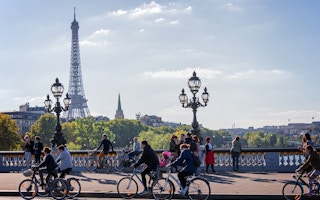Cities and regions are offering record numbers of commitments to reduce greenhouse-gas emissions and build resilience to climate change, according to new figures from the United Nations.
The pledges on climate action from cities and metropolitan regions, as well as the private sector and other major institutions, come just weeks before national government representatives — backed by thousands of local authorities, civil society and business groups, activists and other stakeholders — descend on Paris to engage in what many expect to be negotiations toward a global climate agreement that will last for the coming decade.
Some 2,245 new pledges have recently been entered into the UN’s Non-State Actor Zone for Climate Action (NAZCA) database, an online portal that functions as a central clearinghouse on climate-related commitments by all entities other than national governments.
By mid-November, the NAZCA portal listed some 6,652 such pledges. That included 2,761 separate actions by 935 cities and 117 regions. Nearly 1,800 global companies and more than 400 major investors have also stepped up with formal commitments.
Of the commitments by cities and regions, by far the largest number of actions has to do with reductions in greenhouse-gas emissions (2,173 actions), followed by spearheading new renewable energy projects (860) and bolstering energy efficiency and access (713). Other commitments revolve around strengthening resilience to climate change (211), engaging in cleaner transport options (54) and other actions.
The UN Framework Convention on Climate Change (UNFCCC) called the new figures the “biggest wave yet” of such actions.
“This constitutes the largest single release of such information to date and clearly demonstrates how leading cities, regions, companies and investors are acting to protect the climate and build resilience,” the UNFCCC said in a statement. “It also adds crucial momentum to global efforts to reach an effective new, universal climate change agreement in Paris in December of this year.”
Although cities and regions do not yet have a formal place at the negotiating table in Paris, these pledges are important for multiple reasons. Cities constitute some 70 percent of global emissions, and thus offer a readymade tool with which to tackle the thorny problems of energy use and other climate change amplifiers.
These actions also indicate a clear ground-level action that not only can be ramped up quickly but which are already taking place. This wave of pledges potentially belies the political paralysis that is characterizing climate policy at many national and even international levels.
Further, commitments by national governments — known as Intended Nationally Determined Contributions (INDCs) — do not kick in until 2020. Many say that leaves a critical gap in action that could be filled by city action already underway.
National gap
Those INDCs, meanwhile, have been trickling in over much of this year. Today, nearly 150 countries worldwide have made such formal pledges — an unprecedented number, say experts, and one that adds up to some 88 percent of global emissions (in 2012 figures).
Yet what exactly those national pledges add up to, and whether they will achieve the stated goal of keeping global average temperature rise below 2 degrees Celsius, remains hotly debated. The new NAZCA figures come out just after the United Nations has, for the first time, released an estimate on what the INDCs appear to add up to.
According to that report, the INDCs only get the world about halfway to that 2-degree goal.
“[E]fforts to tackle climate change, including those taken before the Paris agreement and full implementation of the INDCs, could cut up to 11 GtCO2e from projected emissions in 2030,” the report states, referring to gigatonnes of carbon dioxide equivalent. “This is however around half of the total required to reach the global emission level of 42 GtCO2e in 2030 consistent with having a likely chance … of staying below the 2°C target in 2100.”
The report does note multiple options for closing this gap, however, and specifically points to the opportunity in ramping up actions by cities and regions.
“The impact of actions by International Cooperative Initiatives — such as the C40 Cities Climate Leadership Group, the Compact of Mayors, and the Cement Sustainability Initiative — can … be significant,” the report states. “Preliminary assessments indicate an emission reduction in the range of the range of 0.75 to 2 GtCO2e in 2020.”
Other reports have suggested that near-term decision-making by cities could be critical. A third of the remaining global “carbon budget” that is not already locked in by existing operations could be determined by policies made at the urban level between now and 2020, according to a report released last month by C40.
The new findings, prepared in conjunction with the Stockholm Environment Institute, make a powerful case that local pledges toward climate-related goals will provide a meaningful contribution to stem a global need.
Citiscope is a nonprofit news outlet that covers innovations in cities around the world. More at Citiscope.org. This story is originally published here.

















